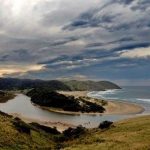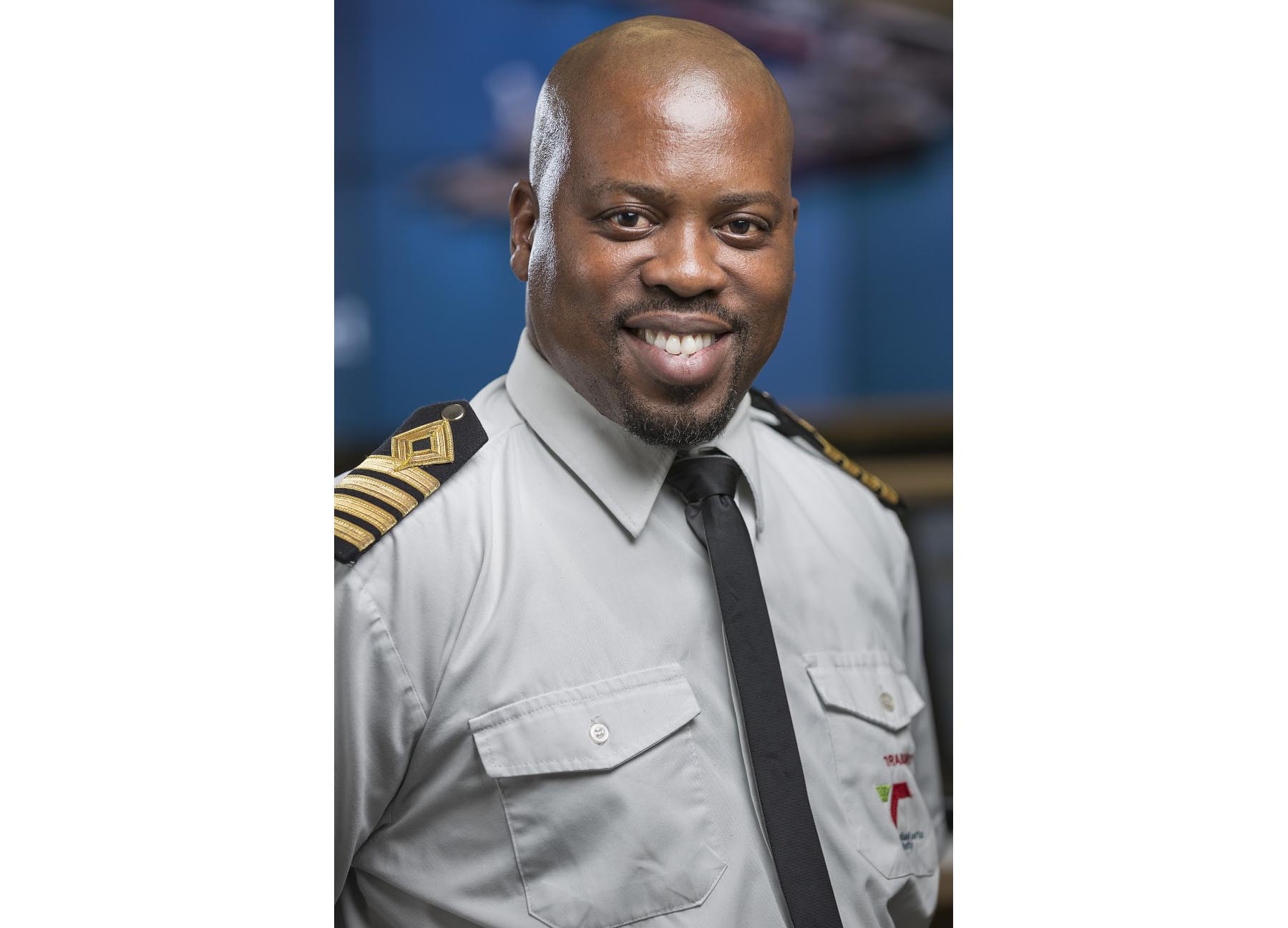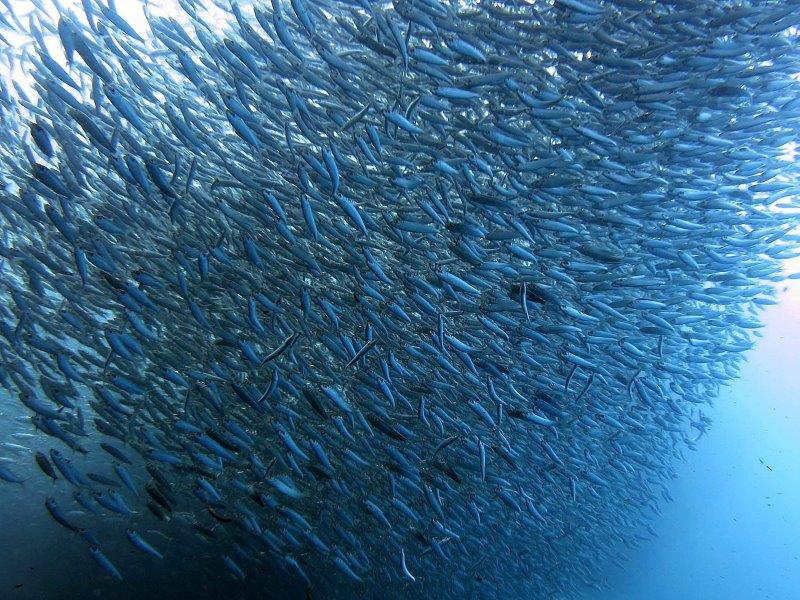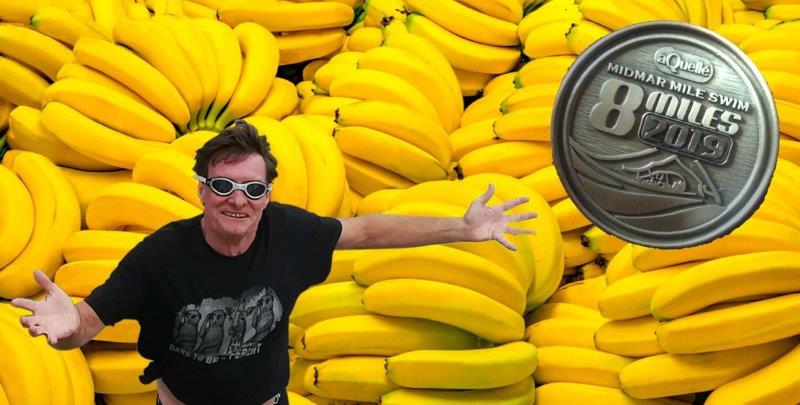Amid the countdown to a pioneering Wild Coast conservation swim, Luke Riley, reflects on how important shark awareness has become for all those involved.
WITH only days go to before the start of The Wild Swim, the lead safety diver, Cera-Jane Catton, accompanied organiser, Fred Kockott on a crash-dive course in shark awareness.
While Catton has vast experience in diving with sharks, including underwater filming of the annual sardine run, Kockott’s previous encounters have been one or two fleeting sightings of what might have been shark fins while surfing.
Toothy creatures
This all changed on Thursday when Kockott came face to face with toothy creatures of the deep on a shark dive organised by Blue Wilderness Shark Adventures.
As the organiser of this week’s conservation swim along a 22km stretch of the Wild Coast earmarked for heavy minerals mining, Kockott said he felt a sense of responsibility in having invited two journalism mates, Mike Loewe and Craig Bishop, and several experienced open water swimmers, to join him.
Their mission, supported by a growing number of fundraising partners, is to raise at least R250,000 for eco-tourism in the area, marine conservation and associated environmental journalism training.
As the sun rose ahead of the Easter weekend, Kockott climbed aboard Blue Wilderness inflatable boat alongside several other first-time shark divers.
Heading through the surf to the backline, they wedged their feet into slots to prevent them from flying overboard on their journey out to Aliwal Reef – a world renowned shark diving site on Durban’s doorstep.
Anxieties
While Kockott worked on controlling fears and anxieties that most would find entirely rational, Catton eagerly awaited the opportunity to swim again with predators of the deep.
“There is no other animal you can safely be with when they feed,” explained Catton. “Yes, sharks can be inquisitive, but we are not their natural prey,” she assured other anxious first-timers.
34-year-old Catton is an active member of Shark Angels – an organisation fighting to protect sharks worldwide. This includes removal of shark nets from Durban’s beaches.
Shark Angel
As the water got chummed with sardines, the distinct fins of Black Tip sharks started cutting through the surface in a feeding frenzy – first three or four, and then plenty of them – at least a dozen.
It was time to enter the water. With his arms held across his chest, Kockott slid over the side and swam to a buoy attached to a bait drum suspended about five metres under the surface.
Apart for the growing number of Black Tip sharks, several of them plus 2 metres in length, the chummed water teemed with remora. These are flat shaped sucker fish that attach themselves to sharks for transportation and protection, also feeding off parasites on the sharks’ skin.

Click here to view more photos of the shark induction dive
Watching from the boat, it was clear that Jess Escobar, the marine biologist leading the Blue Wilderness team, had an equally deep, almost maternal, connection to sharks who she referred to as “my ladies”. She could even tell them apart, saying they had each had unique features and personalities that warranted giving them names.
Smiley
A crowd favourite was Smiley. He had a broken jaw and was incapable of closing his mouth, which, as Kockott soon discovered, made it look like he was perpetually moving in for a bite – a misconception that could easily apply to sharks as a whole thanks to movies like Jaws, said Escobar .
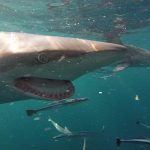
While other first timers clung to a bar suspended between two buoys, Kockott was allowed to dive alongside Catton. Escobar kept a watchful eye, constantly reminding Kockott to keep his arms to his chest lest his hands get in the way of the feeding sharks.
Then came the moment Escobar had planned from the outset. She instructed a colleague to chum the surface next to boat, and then led Kockott directly through a small but dense pack of feeding sharks.
If Kockott was to be among the pioneering wild swimmers, best he know what to do on encountering a shark, Escobar reasoned.
Close encounters
Kockott’s first cheek-to-cheek encounter with sharks soon had him asking for more.
Afterwards, an exhilarated Kockott joked about being so close to the sharks mouths he could have “flossed their teeth”. Associated underwater GoPro footage shows Kockott’s head being knocked out the water at one stage by the dorsal fin of one the larger Black Tips as it pushed him out its way.
This chance to get comfortable with sharks in their own environment was something Kockott said he would be forever grateful for.
Survey
The 56-year-old said he had managed to put a lid on his fears and found ease among Aliwal Shoals’ Black Tips. But he admits that the idea of encountering other species of sharks on The Wild Coast, such as Zambezis (bull Sharks), Tigers or possibly even a great white, was “pretty unnerving”.
He said the Blue Wilderness shark dive, was a first step toward conquering those fears. “Having organised The Wild Swim, inviting others to join me, I really don’t have a choice but to conquer these fears,” said Kockott. “And thankfully we have CJ and Emil Pirzenthal (a legendary diver from the South Coast) on our team.”
Kockott said while most of the wild swimmers did not want to get a glimpse a shark during The Wild Swim, Catton and Pirzenthal saw it as an opportunity to do an informal survey of sorts.
“They hope to have many sightings, but have assured us we will be safe,” said Kockott.
“Unless a shark really gets close, I don’t think the swimmers will even notice,” said Pirzenthal. “We will see any shark long before any swimmer does, and dive down and push it away,” said Pirzenthal, demonstrating how he uses his shark prodder – a hollow PVC pipe – like a pool cue.
On her role, Catton said: “My experiences will hopefully show that these misunderstood fish should be treated with respect and caution, but not feared.”
“There are numerous other potential risks on the Wild Coast,” added Catton. “While sharks are among them, if you approach possible encounters in the same way you would rough surf, or blue bottles for example, then you can successfully manage that risk – and yes, even enjoy the experience. Like any wild animals when you enter their territory, they must be treated with deference.” – Additional reporting, Phil Space, Roving Reporters
- Luke Riley is a political science and communications student at the University of Maryland. This story was produced with the support of the School for International Training (SIT) Study Abroad programme and the Human Elephant Foundation.
Don’t be gungho, warns John McCarthy

While Roving Reporters director, Fred Kockott reckons his shark induction dive on the Aliwal Shoal was very useful preparation for The Wild Swim, words of caution from legendary ocean water adventurer, John McCarthy, remain foremost on his mind. Besides the Wild Coast’s rugged terrain and rough surf, black tips off Aliwal Shoal were not in the same league as sharks found on the Wild Coast, McCarthy recently told Kockott. Click here to read more about shark factor – and not just those in the ocean deep.

